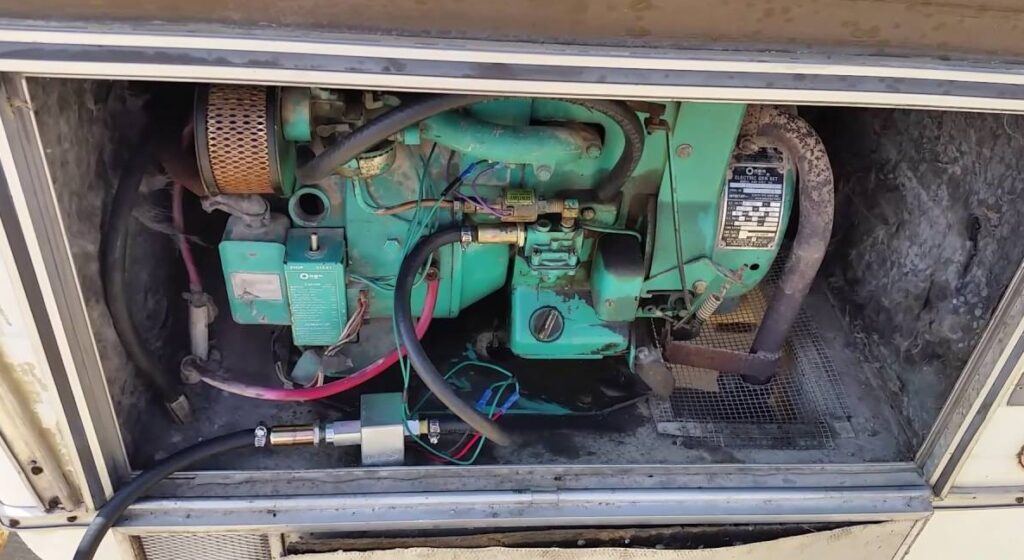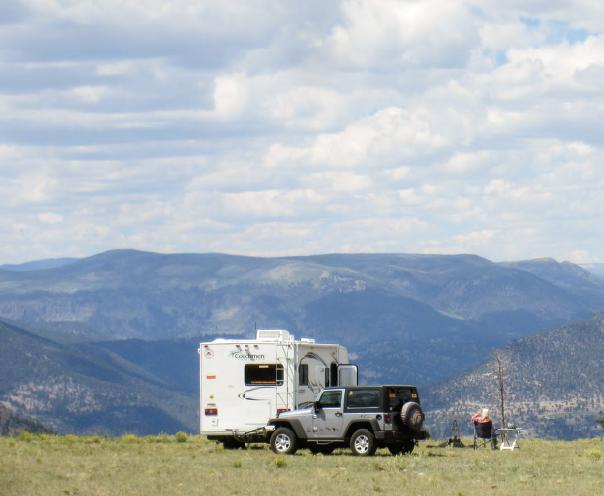Article and photos by MARK NEMETH #45776
When you’re boondocking far away from electrical hookups, you’ll be operating your RV on its 12V battery system. Your house batteries will provide 12V power for lights, fans and appliance controls, but if you want to run AC appliances or devices, you’ll need to manufacture your own 120- volt AC power. That means you’ll need either a generator, or an inverter or both.
Purpose of RV Generators
A generator converts the energy in a fuel (gasoline, diesel, propane) into electricity. In an RV, a generator can provide power to run small electrical devices and chargers, charge your house batteries, run air conditioners and large appliances and keep your TV and satellite dish going. Unfortunately, generators are also noisy, require maintenance, and can burn through quite a bit of fuel.
A typical RV generator will consume one gallon (or more) per hour when running a big load, such as an air conditioner. When only running smaller loads, like a TV and a phone charger or two, it will still consume up to one-half gallon per hour.
The Purpose of RV Inverters
An inverter is an electronic device that converts 12V DC power to a reasonable simulation of 120V AC power. This will allow you to operate many of your appliances and accessories that require AC power without the noise and cost of operating a generator. Inverters range from simple portable units that plug into a cigarette lighter to larger, hard-wired units that are permanently installed. AC wattage ratings are available from 100 watts up to 4,000 watts or more. Inverters are great for smaller electrical loads, but it’s difficult to operate large electrical loads (air conditioners and major appliances) with an inverter. To explain why, we need to do some math.

This compartment, in a 19 ' class-C rig, originally housed this Onan AJ 3000W built-in generator. The compartment was later repurposed to hold a small 1000W portable generator.

What we need to do first is figure out how many DC amps the inverter will draw when it is making that AC power for your appliances. Put simply, for every 100 watts of AC power that your inverter is producing, it needs to draw about 10 amps from your 12-volt battery system. For inverters rated at 90% efficiency, the number is closer to 9.25 amps per 100 watts, but for ease of calculation, just assume that 10 amps of DC power will produce 100 watts of AC power. It’s easier to calculate that way and errs on the side of safety. For those of you who must have the math, here it is: WATTS=VOLTS X AMPS, SO AMPS=WATTS/VOLTS. For an inverter, operating at 90% efficiency, the conversion can be represented thus: AC watts /12 volts X 1.11=DC amps. Example: a 100W light bulb in a lamp, operating on your inverter, will draw about 9.25 amps from your batteries. 100/12 X 1.11=9.25 amps
Now, let’s do that same calculation with a microwave that consumes 1200 AC watts: 1200/12 X 1.11=111 amps!
The reason that this is important is that you only have a fixed capacity in amp/hours available from your house battery bank. A pair of 6V deep cycle batteries or a pair of group-24 12V batteries will have a capacity of about 200 amp hours. That means that if you run that lamp from the previous example for about 20 hours, your batteries will be dead since 9.25A X 20 hours =185 amp hours. The microwave would use up all your battery capacity in less than two hours run time. Okay, so now we know that inverters are best used for smaller electrical loads, and that generators are best used for larger AC appliances and loads. How do we translate that into what we need for our RV?
What’s the Ideal Setup for Boondocking?
I think the ideal setup is a generator with enough capacity to run everything in the RV when you need it, and an inverter that will support all the small devices and appliances, so you don’t have to run the big generator just to charge your laptop. If you have a large RV, and it already has a built-in generator, you’re halfway there.
Let’s say you’re boondocking in a large motorhome or towable RV, with a built-in generator rated anywhere from 5000W to 10000W. Run the big generator when you need to run air conditioning or other AC appliances, like the microwave, hair dryer, coffee maker, etc. Add a small inverter, rated about 1000W, to operate all your electronic devices: TVs, computers, chargers, etc. This set up works well with smaller house battery banks of two to four batteries, because you’ll be running the generator enough to keep the batteries charged, and your inverter use is primarily for low demand devices.
If you don’t want to mess with installing an inverter, run the big generator for big appliances, and purchase a small portable generator, like a Honda EU1000 or EU2000, to provide power when you are operating smaller loads and devices. Those little Hondas are amazingly quiet and fuel efficient.
If you’re boondocking in a smaller trailer or motorhome, the space and cargo capacity limits your options somewhat. Many smaller RVs don’t come with a built-in generator and battery banks are small as well, usually only one or two batteries. Your best option is a portable generator, backed up by an inverter, but these devices come in various sizes. How do you select the right ones?
Choosing a Portable Generator For Your RV
Portable generators are self-contained units. They have their own fuel tank and can be moved from place to place. Smaller units can be carried; larger ones usually roll around on a set of wheels or casters. Some of the larger units are electric start, but most of the smaller ones must be started with a pull cord. Typical ratings are 1000W up to about 6,000W. Most portables run on gasoline, although there are some out there that can be run on propane.
The least expensive portable generators are called contractor generators because they are designed for use on construction sites to provide power for tools. These generators are an engine and generator head mounted in an open frame and are very loud. Because of their size, weight and noise, they are not a good choice for an RVer who wants a portable generator. A better choice would be an inverter gener- ator, such as the Honda EU generator line. These units tend to be very quiet and fuel efficient.
I have a 19′ class-C, and it has a single roof air conditioner and a 30A cord. This is pretty typical for RVs under 30 ft. It was originally equipped with an Onan AJ 3000W built-in generator that weighed 160 lbs. and was very noisy and unreliable. I could have replaced it with a newer unit rated around 3000W, which would have been big enough to run my roof air, but instead, I chose to repurpose the compartment it was in and go with a small 1000W portable generator. This would mean that I would no longer be able to run my roof air when boondocking, but I decided that if I was traveling in hot weather, I’d just go to an RV park and pay for hookups. I figured it would cost me $15 to $20 in fuel to run the generator all night, so why not just pay for a site instead? Plus, it would be a lot quieter!
The Honda EU1000 was the obvious choice, with it being light enough, at 26 lbs., to easily handle, and small enough to fit into my available space. Either the EU1000 or EU2000 (at 46 lbs.) are a good choice for folks with smaller RVs who don’t need to run the roof A/C while boondocking. If you want to have the option of running your air conditioner, you’ll probably need a 3000W generator or a pair of EU2000s. Yes, it can be possible to run a 13.5K BTU roof air with a single Honda EU2000, but even with a soft-start kit on the A/C and everything else in the RV turned off, it’s marginal at best.
A pair of EU2000s can be linked together with a parallel cable and will provide enough power to run the roof air and just about anything else as well. The advantage is that you can run only one generator if you don’t need the air conditioner. The disadvantage is you now have two generators to stow and maintain. A Honda EU3000 is an option, too. it will definitely handle the A/C, but it weighs about 135 lbs, so it’s really not all that portable. It takes two people to lift it, so it’s not great for solo travelers. At 30″x 18″ x 22″, it’s big, which limits storage options.
You probably noticed I’m pushing Honda generators. That’s because I believe they are the best out there. You can buy a wide range of cheaper generators, many of them clones of the original Honda designs. However, they are generally not as quiet, fuel efficient, or long-lasting as the Hondas. A cheap generator is probably okay if you only use it occasionally, but if you want a dependable generator that will stand up to heavy use and last for years, spend the extra money and buy a Honda.
Remember, when deciding how big a portable generator you need, be sure to take into account the weight of the generator, the size of available storage space and what you want to run with it.


Choosing an Inverter
Inverters are a little easier to figure out. Smaller ones are often plugged into a cigarette lighter and run small loads, while larger ones are hard-wired into the RV’s battery system to support bigger loads.
Inverters come in two types: modified sine wave and true sine wave. The modified sine units are cheaper, but the power they produce is a bit “choppy” and may not work well with sensitive equipment. They also tend to be less energy efficient. True sine inverters are more expensive, but produce a smooth and correct sine wave output, and have a higher conversion efficiency (they use less DC amperage to produce AC power). Most folks will be well-served by an inverter rated between 1000W and 2000W, and you can choose a stand-alone inverter, or an inverter/charger combo designed for RVs that is also a high-quality battery charger. This is a great option, especially if your RV came with a clunky old converter instead of a 3-stage charger. If you have minimal AC power needs, you might prefer a small 150–350W inverter that plugs into a cigarette lighter socket. These are great for charging cell phones, laptops and running small TVs.
For my RV, I chose a 1000W true sine unit made by Xantrex. It runs everything I need it to, including the refrigerator on AC power while I drive, and my tiny 600W microwave. It is also a hard-wired unit and has a remote switch to turn it on and off.
To Sum it Up
When you boondock, you become a power system operator, as you must make your own AC power. Generators and inverters provide you with options to generate the power you need to enjoy life off the grid. Hybrid systems, with both a generator and an inverter, offer the best flexibility and efficiency. In the next issue, we’ll continue our power odyssey and cover batteries and chargers!
Did you like this post? Pin it to Pinterest!


Author
Mark Nemeth
Mark travels in a small class-C and has made numerous modifications to his RV to enable him to boondock more easily. He’s not saying he’s an expert, or the primary source for boondocking information, but he’s done it for a number of years and is happy to share some things that he’s learned the hard way.












3 Responses
Do you need a different battery charger for lithium batteries ?
You say to use the inverter for smaller electrical loads and (portable) generator for larger loads. How do you do that physically when the large loads are hard-wired or plugged in (hidden behind walls) inside your trailer? Do you plug the portable generator into the plug on the camper? (We have a 30ft tow-behind camper). Thank you.
Thank you for your question, Dave. Yes, you will plug your trailer into the portable generator. If your portable generator has a 30 amp receptacle (assuming your camper is 30 amp) you can plug your trailer in using your regular 30 amp cord. Otherwise, you may need to use an adaptor and a different extension cord to plug your camper into the generator.